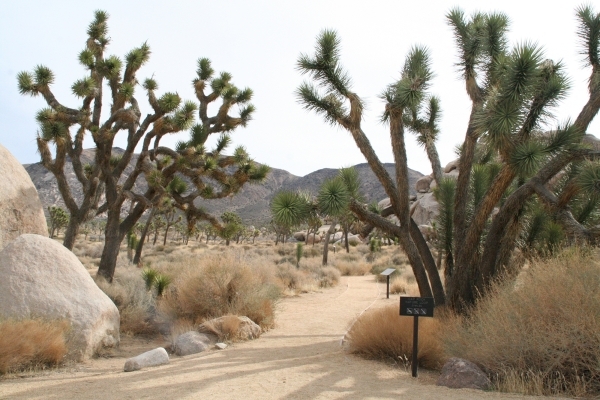Joshua Tree National Park packs in plenty to do

Joshua Tree National Park, just outside of Twentynine Palms, Calif., is often overlooked in favor of better-known parks, but it shouldn’t be. The park is home to not only the signature Joshua tree but also five desert palm oases, 8,000 climbing routes, 191 miles of hiking trails and plenty of wildlife and wildflower viewing opportunities on both paved and unpaved roads.
With elevations ranging from 536 feet to 5,814, it sprawls over nearly 800,000 acres. That’s room enough for two large desert ecosystems. In the eastern region of the park, below 3,000 feet, you will be in the Colorado Desert (part of the Sonoran) where vegetation primarily consists of creosote, palo verde, ocotillo and cholla cactus. In the western area, the Joshua tree dominates the landscape.
There are only 158 fan palm oases in North America, and this park boasts five of them. From Las Vegas, the closest one in the park is the Oasis of Mara. Start your visit at the Oasis Visitor Center, where you will find a paved, flat, half-mile loop trail around the palms.
The special plant that dominates these oases is Washingtonia filifera, the only native palm in western North America. These palms live an average of 150 years and can grow to 75 feet tall. They only grow where there are copious amounts of water. These areas of underground water in the park are available because of earthquake faults and fractures. Fault lines force water to the surface.
Visiting the park’s other four palm oases requires more effort. The 49 Palm Oasis trailhead is located about a 6-mile drive from the Oasis Visitor Center, and to see it, you will have to hike a moderate 3-miles round trip.
The other three oases are in the park’s southern region, about an hour’s drive from the Oasis Visitor Center. These three oases share the same trailhead, which is located about 1 mile from the park’s Cottonwood Visitor Center. The first one you will find is the Cottonwood Spring Oasis, less than a five-minute walk. If you continue on about 3½ miles, you will find the Lost Palm Oasis. I wouldn’t recommend trying to find Munsen Canyon Oasis, a few miles farther along. Those miles constitute an extremely difficult route-finding mission and involve strenuous rock scrambling.
These palm oases support a wide variety of wildlife. Desert bighorn sheep and coyotes are regular visitors, and sometimes during spring migration, a couple of hundred turkey vultures can be seen. The western yellow bat roosts here, and hooded orioles build their nests under the palm leaves.
Wildflower season in the park is just now beginning and usually lasts through early May, depending upon which part of the park you visit. Right now, the best colors are likely to be found in the lower-elevation areas. Look for blooms from the chuparosa and bladderpod bushes, desert globemallow, desert star-vine and desert lavender.
Joshua Tree is also a fine place to go bird-watching. More than 250 kinds of birds have been recorded in the park with about 78 known to nest here, including Bendire’s thrasher, western kingbird and ash-throated flycatchers. Year-round residents include birds of prey, such as American kestrel, prairie falcon, great horned owl and a variety of hawks.
You’ll probably want to make this one an overnight trip, and campers in the park enjoy some of the darkest and therefore starriest skies in California. However, the park website notes that the first-come, first-served sites fill up on weekends from October through May. But among the helpful information the website provides are links to chambers of commerce in surrounding small towns, which include alternate campsites and lodgings.
The Joshua Tree Visitor Center and the Oasis Visitor Center are open from 8 a.m. to 5 p.m. daily. The Cottonwood Visitor Center is open from 8:30 a.m. to 4 p.m. daily. Bring 2 gallons of water per person, per day, for potable water is available only a few places in the park. Otherwise, there are no services in the park, but most can be found in Twentynine Palms or the town of Joshua Tree. Visit nps.gov/jotr.
— Deborah Wall is the author of “Great Hikes, A Cerca Country Guide” and “Base Camp Las Vegas: Hiking the Southwestern States,” published by Stephens Press. She can be reached at deborabus@aol.com.